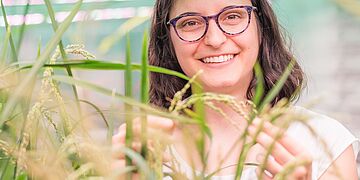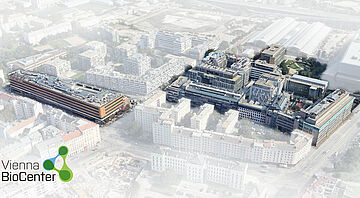Valeria Estrada Navarro joined the Busslinger Lab at the IMP from Tecnológico Nacional de México. Valeria’s project aims to set up a CRISPR/Cas9 screening protocol to identify novel regulators of plasma cell development and function. Plasma cells produce antibodies and contribute to immune memory.
Harry Orrin from the University of Oxford in England is conducting his project in the Plaschka Lab at the IMP. For his Summer School project, Harry characterizes the molecular marks that differ between mature and immature mRNA, and how they play a role in mRNA export from the nucleus into the cytoplasm.
Zoë Kentischer from the Technical University of Munich in Germany joined the Obenauf Lab. She aims to decipher the molecular mechanisms that lead to immunotherapy resistance in cancer patients. Particularly, she focuses on immunotherapies that involve the use of immune-checkpoint inhibitors and adoptive cellular transfer.
The Pauli Lab at the IMP is hosting Mireia Codina Tobías from Pompeu Fabra University in Spain. Mireia studies the balance between a chemokine and its receptor that guide the migration of mesodermal cells during zebrafish embryonic development. Her project aims to visualize the self-generated gradient resulting from the dynamic interaction of these two proteins.
Aster Witvliet, from Radboud University in the Netherlands is the last of IMP Summer School Students. In the Peters Lab, she is investigating the relation between cohesin’s protein structure and its cellular functions. Aster generates mutants for one of the cohesin proteins and evaluates its functionality in cells.
Yuchen Wu studies at Cambridge University in England and joined the Kubicek Group at CeMM. For his project, Yuchen combined experimental and computational approaches to investigate the function and inhibitors of the protein SMNDC1.
The Bergthaler Group at CeMM also welcomed a Summer School student this year. Bella Somoza from Cornell University in the United States investigates the role of ammonia in the immune system’s response to infection, and how it may affect the brain to induce sickness-related behavioral changes.
Coming to us from Freie Universität Berlin in Germany, Andrea Rodi joined the Ameres Group at Max Perutz Labs. Andrea is working on RNA modifications, which play an important role in RNA maturation, function, and decay. Specifically, she is investigating a previously uncharacterized enzyme in Drosophila that adds uridines to the 3’ ends of RNA.
Pauline Vinet from the University of Toulouse 3 Paul Sabatier, France, is running her project in the Otsuka Group at Max Perutz Labs. Her aim is to examine if the amount of endoplasmic reticulum and nuclear envelope membrane could change during the cell cycle. To answer this, she works to measure membrane surface area from 3D electron microscopy images.
Christopher Neimeth from Stanford University in the United States is hosted by the Leonard Group at Max Perutz Labs. Christopher is working to purify and crystallize SGK3, a kinase that is a part of the PIK3 pathway, using cloning techniques to overexpress SGK3 in insect cells.
The Bücker Group at Max Perutz Labs is also hosting a student this summer. Patricia Rothe, from Freie Universität Berlin, tests whether previously identified enhancers with weak intrinsic activity but high levels of RNA Polymerase II binding activate transcription through RNA Polymerase II recruitment or through RNA production from these enhancers.
Colleen Russett from McGill University, Canada, joined the Berger Lab at GMI. She investigates the recognition of Arabidopsis transposable elements by endogenous transcription factors. Currently, she is using a fission yeast-based reporter system to test the activation of genes under control of transposable element-derived promoters.
Sarah Barnes from the University of St. Andrews in Scotland is working on her project in the Brennecke Lab at IMBA. Sarah’s project focuses on devising and characterising an in vivo tool to determining the localization of the Heterochromatin protein 1 variant Rhino, which is involved in germline transposon repression in Drosophila melanogaster.
The Mendjan Lab at IMBA is hosting Emilija Jovanovic from the University of Belgrade in Serbia. Emilija uses self-organizing cardiac organoids, or cardioids, to understand heart development and regeneration at the cellular level.
Christoph Oberist from Eberhard Karls Universität Tübingen in Germany works in the Gerlich Lab at IMBA. Christoph wants to find out how cohesin folds replicated copies of genes on each sister chromatid, where copies are physically linked, and how cohesin is positioned by the transcription machinery.
If you want to boost your career and join the Vienna BioCenter Summer School in 2022, keep an eye out for our call to applications starting 1 December 2021 or follow the Vienna BioCenter Scientific Training channel on Twitter.
For individual portraits of this year's students, see the Vienna BioCenter Scientific Training Twitter thread.



